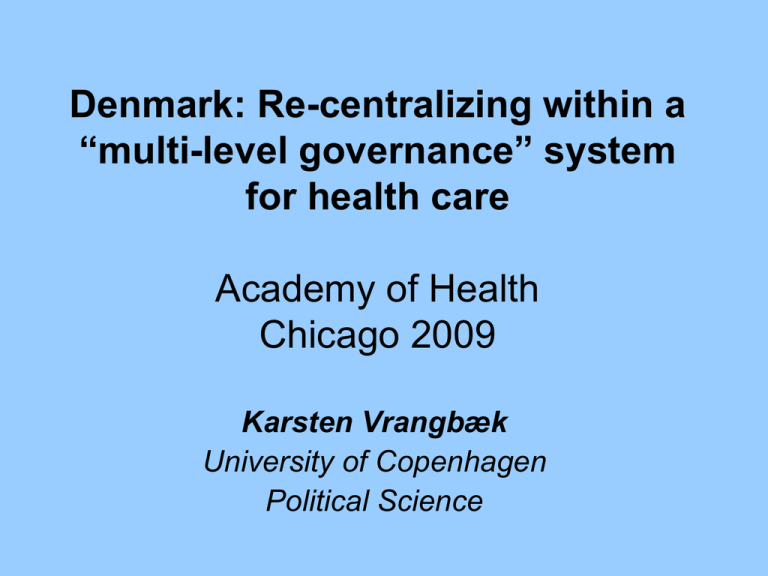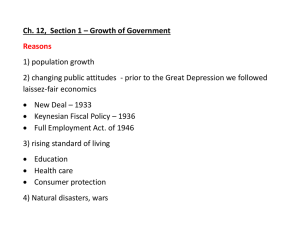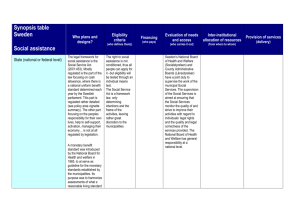Denmark: Re-centralizing within a “multi-level governance” system for health care Academy of Health
advertisement

Denmark: Re-centralizing within a “multi-level governance” system for health care Academy of Health Chicago 2009 Karsten Vrangbæk University of Copenhagen Political Science Denmark: background • • • 5.1 million inhabitants One of the oldest kingdoms in the world. Democratic governance system since 1849 (in the present form since 1901/1914). – Parliamentary tradition for minority and coalition governments. Extensive welfare state, largely delivered through decentralized authorities (municipalities and regions with democratic management) – “Negotiated multi-level governance system” The Danish health care system Tax funded and publicly managed, although with some private delivery (general and specialist practitioners, few private hospitals) Coverage is universal. All those registered as residents in Denmark are entitled to health care that is largely free at the point of use. HC expenditure at 9.5% of GDP. $3349 per capita (US: 15.3% and $6714) (2006: OECD) How is the delivery system organised? Five regions are responsible for providing hospital care and own and run hospitals The regions also finance general practitioners, specialists, physiotherapists, dentists and pharmaceuticals. The 98 municipalities are responsible for public health, school dental care, rehabilitation outside hospitals How is the delivery system organised? Physicians: Hospital physicians are employed by the regions and paid a salary. Private general practitioners act as gatekeepers to secondary care and are paid via a combination of capitation (30%) and fee for service. Non-hospital based specialists are paid on a fee for service basis. Hospitals: Almost all hospitals are publicly owned (95+ % of hospital beds are public). They are paid by the regions via general budgets and some fee for service. Dynamic elements in the multi-level governance relations State-regions: • Annual negotiations on expenditures/activities • National level legal framework (e.g. on choice and waiting time guarantees), and national planning functions via National Board of Health • Block grants and negotiated (semi-hard) budget constraints. • Some targeted activity based funding Regions-hospitals • Global budgets and some activity based funding • DRG system for payment and accounting • Rationalization policies (shorter in hospital stays/more day surgery, information systems, elective surgery units, concentration of acute care etc) • Regions negotiate collective agreements with medical professionals on payments and working conditions Dynamic elements in the multi-level governance relations Regions-General Practitioners • Combination of capitation and fee for service payment • Regions negotiate collective agreements with private practitioners on fees and general organizational issues. Regions and GPs coordinate implementation. • Regions monitor activity profiles of GPs. Significant deviation leads to dialogue Municipalities-regions • Mandatory health plans including plans for coordination with regions. Municipal co-financing of hospital care (general and activity based) Decentralization of welfare services Decentralized management of welfare services has deep historical roots in Denmark. • Viking age and local village councils • Local area management of early welfare policies (poor relief, local hospitals etc) before the social-democratic welfare state was established Decentralization of welfare services A major reform in 1970 consolidated the decentralized public welfare structure 14 counties (plus Copenhagen city) gained ownership of almost all hospitals and became responsible for financing (mostly through income taxes) and providing health care. Both counties and municipalities governed by democratically elected assemblies Decentralization of welfare services The 1970 reform was based on ideas of strong public welfare provision by democratically governed decentralized authorities. Proximity to users should encourage participation, legitimacy and the right mix and level of services to fit local needs Local politicians held accountable by local population for both service level and taxation. Smaller entities would be more agile and flexible in adapting to specific contingencies. Decentralization of welfare services The decentralized structure has worked relatively well (in terms of delivering universal coverage at a relatively low cost, and in terms for finding pragmatic, workable solutions) But…….. Challenges for the de-centralized structure Economic pressure on the welfare state from the 1980s onwards led to stronger state control over finances and general rationalization measures. – Budget negotiations and block grants make decentralized authorities more responsible to the state, in addition to own tax payers Some coordination problems and “grey zones” between the different levels. – E.g. Long term care, specialized social services Some municipalities were too small to handle the risk of high cost social cases, and to maintain a sufficient level of expertise. Similar issues for some hospital care. – (Partly handled through voluntary collaboration). – Waiting times and life expectancy as indicators of system performance Re-centralisation A major structural reform in 2007 established five regions instead of 14 counties. 271 municipalities were amalgamated into 98. • Tasks and responsibilities within the public sector were redistributed between state, regions and municipalities. • The main task for regions is hospital and outpatient care for citizens. Municipalities are responsible for rehabilitation and health promotion etc. – Municipal co-financing of regional health expenditures • Financing of health care through national taxation, redistributed to regions and municipalities as block grants and some activity based funding • The National Board of Health gained stronger powers in planning and follow up. Why re-centralization reform? Functional explanations: • Small municipalities and regions were unable to deliver at a sufficiently high level of quality • Emphasis on “benefits of scale” and “quality through specialization and practice” within health care. – Improving quality (and perhaps efficiency) through consolidation of acute care functions and elective surgery. • Less acceptance of differences in delivery due to decentralized decisions • Advanced monitoring systems enable comparisons and stronger national control • Changing perceptions of local democracy Why re-centralization? Political explanations • • • • Government with majority backing, and strong commitment to improve health care (waiting lists and poor life expectancy). – Structural reform became the answer. Conservative party in government coalition had poor representation at the county level (and close links to industry) Industry stake holders pushed for streamlining the public sector (and lower taxes) National level frustration by being held accountable for health care, while not having direct control. – The reform strengthens state fiscal control and control over infrastructure decisions, placement of specialties etc. (“carrots and sticks”) Assessing the results • • • Implemented 2007. No major national evaluation yet. Full effects will only be realized in the long term Time series comparisons of efficiency/quality are complicated by other intervening factors e.g. increased funding for health care and ongoing changes in organizational and steering functions. Waiting times were negatively affected by a major national nursing strike Assessing the results • • • The reform consolidates the tendency for stronger state involvement (financing, new infrastructure investments, planning of specialized functions). Some frustration at the regional political level Coordination issues not eliminated but “rules of the game” have changed somewhat Still a negotiated “multi-level governance system”, but with larger decentralized entities and a stronger role for state, municipalities (and private actors). - The current regional governance system may not be politically sustainable in the longer term




